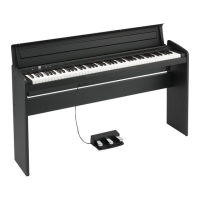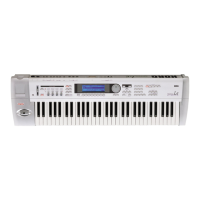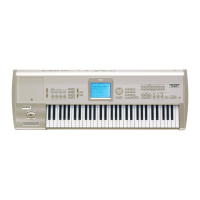Program mode
60
Center [C–1...G9]
This specifies the note that will be the break point in the
center of keyboard tracking. At this key, the keyboard
tracking has no effect on the volume, or on any AMS
destinations.
Key High [C–1...G9]
This specifies the note that will be the break point
connecting the two sloped lines in the high region.
Entering notes from the keyboard
You can enter velocity values directly by playing them on
the keyboard. To do so:
1. Select one of the Key parameters.
2. Hold down the ENTER switch.
3. While holding ENTER, play a note on the keyboard.
Ramp:
Positive ramp values mean that the keyboard tracking
output increases as you play farther from the Center Key;
negative ramp values mean that it decreases.
Because of this, the meanings of positive and negative ramp
settings will change depending on whether the ramp is to
the left or right of the Center Key.
Btm Lo (Bottom-Low) and Lo Cent (Low-Center): negative
ramps make the keyboard tracking’s output go down as you
play lower, and positive ramps make the output go higher.
Cent Hi (Center-High) and Hi Top (High-Top): negative
ramps make the keyboard tracking’s output go down as you
play higher, and positive ramps make the output go up.
Differences from other Keyboard Tracks
There are several differences between the Amp keyboard
tracking and the Filter and Common keyboard tracking.
For example, the results of the Ramp values are different. As
shown in the graphic “Amp Keyboard Tracking,” below,
negative slopes are more steep than positive slopes.
Also, the amp does not have separate control of Intensity.
Instead, Intensity is always fixed at the maximum amount,
allowing keyboard tracking to change the volume from
complete silence to twice as loud as the programmed level.
Btm Lo (Bottom-Low) [–Inf, –99...+99, +Inf]
This sets the slope between the bottom of the MIDI note
range and the Key Low key. For normal key track, use
negative values.
Lo Cent (Low-Center) [–Inf, –99...+99, +Inf]
This sets the slope between the Key Low and Center keys.
For normal key track, use negative values.
Cent Hi (Center-High) [–Inf, –99...+99, +Inf]
This sets the slope between the Center and Key High keys.
For normal key track, use positive values.
Hi Top (High-Top) [–Inf, –99...+99, +Inf]
This sets the slope between the Key High key and the top of
the MIDI note range. For normal key track, use positive
values.
+Inf and –Inf ramps
+Inf and –Inf are special settings which create abrupt
changes for split-like effects. When a ramp is set to +Inf or
–Inf, the keyboard tracking will go to its extreme highest or
lowest value over the span of a single key.
When a ramp is set to +Inf, the keyboard tracking will go to
its highest value (double the programmed volume) over a
single half-step.
Similarly, when a ramp is set to –Inf, the keyboard tracking
will go to its lowest value (complete silence) over a single
half-step.
Note: If you set the Cent Hi (Center-High) ramp to +Inf or
–Inf, the Hi Top (High-Top) parameter will be grayed out.
Similarly, if you set the Lo Cent (Low-Center) ramp to +Inf
or –Inf, the Btm Lo (Bottom-Low) ramp will be grayed out.
Amp KTrk is also an AMS source
You can use the keyboard tracking as an AMS source to
modulate other parameters, just like the envelopes and
LFOs. Simply select Amp KTrk in the AMS list for the
desired parameter.
Ramp Change in level
–Inf Silent in one half-step
–99 Silent in one whole-step
–95 Silent in one octave
–48 Silent in two octaves
–25 Silent in four octaves
00 no change
+25 x2 in four octaves
+50 x2 in two octaves
+99 x2 in one octave
+Inf x2 in one half-step
–99 –97 –95 –48 –25
+99 +50 +25
High Break: C4Low Break: D1 Center: G2
Change to
Ramp values:
Ramp values:
Amp Keyboard Tracking
Louder x2
Silence
No change
Volume

